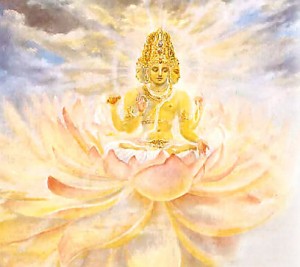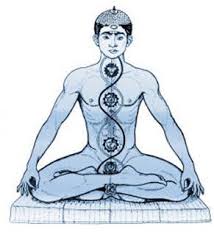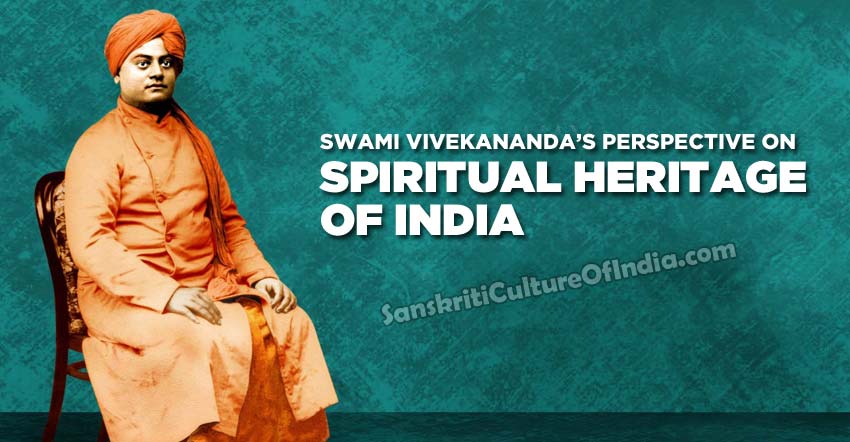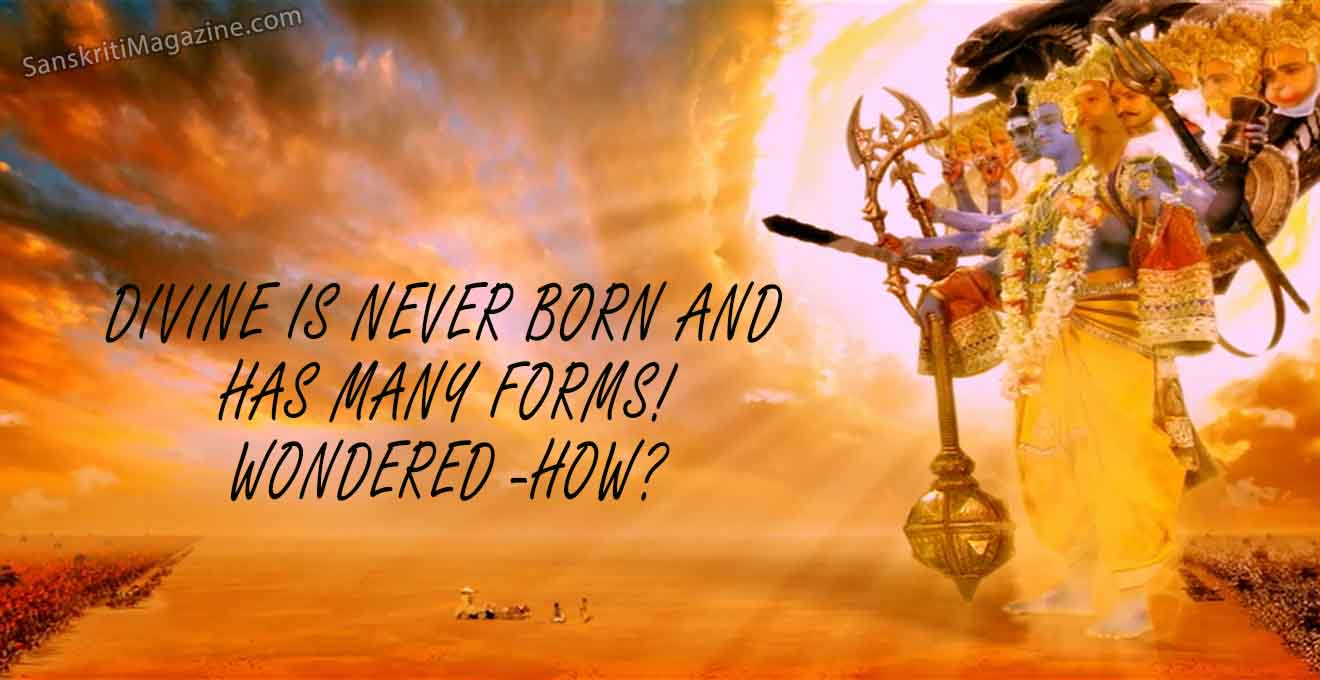According to Swami Vivekananda (1863-1902), a great spiritual leader, thinker and reformer of India, spirituality is the very backbone of India. He observes that every nation has a particular ideal running through its whole existence, forming its very background. With some it is politics, while with others it is social culture, intellectual culture, and so on. Vivekananda says, …. Our motherland has religion and religion alone for its backbone, for the bedrock upon which the whole building of its life has been based.’ Since spirituality is the essence of religion, we should mark that Vivekananda has used the term religion in the same sense as spirituality
 If we study the history of Indian culture we find even in the Rig Veda, the oldest of scriptures, the Indian mind experiencing the intimation of something divine and immortal within itself. The inward search of man gathers volume and power in the Upanishads. The Upanishads seek to realize the transcendental dimension of man-the dimension of Divinity transcending humanity. In this spiritual direction human awareness goes beyond the body, the sense and the surrounding world: man realizes himself as the immortal Self. Coming in the wake of the Upanishads, the Bhagavad Gita works out a complete philosophy of life, reconciling the sacred and the secular, work and worship. The spirituality that proceeds from the Vedas and the Upanishads, and reinforced by Sri Krishna, Buddha, Shankara and others, is liberated into universality by Swami Vivekananda. He invests religion with the power to illumine and guide human life as a whole. The present paper is an exposition and analysis of Vivekananda’s interpretation of Vedanta, which is also known as the Hindu religion. We shall strive to focus on the points where his interpretation regenerates the spiritual, heritage, making it fit for the modern world.
If we study the history of Indian culture we find even in the Rig Veda, the oldest of scriptures, the Indian mind experiencing the intimation of something divine and immortal within itself. The inward search of man gathers volume and power in the Upanishads. The Upanishads seek to realize the transcendental dimension of man-the dimension of Divinity transcending humanity. In this spiritual direction human awareness goes beyond the body, the sense and the surrounding world: man realizes himself as the immortal Self. Coming in the wake of the Upanishads, the Bhagavad Gita works out a complete philosophy of life, reconciling the sacred and the secular, work and worship. The spirituality that proceeds from the Vedas and the Upanishads, and reinforced by Sri Krishna, Buddha, Shankara and others, is liberated into universality by Swami Vivekananda. He invests religion with the power to illumine and guide human life as a whole. The present paper is an exposition and analysis of Vivekananda’s interpretation of Vedanta, which is also known as the Hindu religion. We shall strive to focus on the points where his interpretation regenerates the spiritual, heritage, making it fit for the modern world.
The Nature and Goal of Religion in Vivekananda’s View
The spiritual thoughts of Vivekananda have their moorings in the Vedanta philosophy, which is a systematic exposition of the Upanishads. However, he gives a modern interpretation of the ancient ideas to make them practical. He says, The Vedanta, therefore, as a religion must be intensely practical. We must be able to carry it out in every part of our lives.’ (2.291)
The fundamental and most universal principle of the Vedanta is that the individual soul is identical with the supreme Soul. Vivekananda expresses it thus: Each soul is potentially divine. The goal is to manifest this Divinity within… (1.257). In his view, purity and goodness are inherent characteristics of the soul, and religion is nothing but the manifestation of this true nature. In order to make religion practical, Swamiji begins with emphasis on the importance of morality and moral behavior. Religion for him means living in a way that helps us manifest our higher nature, truth, goodness and beauty through our thoughts, words and deeds. All impulses, thoughts and actions that lead one towards this goal are naturally ennobling and harmonizing, and are moral in the truest sense. Hence morality, which is indispensable to being truly religious, is simply a matter of being what one really is, simply radiating the true light of one’s own soul all around, under all circumstances, at all times.’ Thus by spirituality Swamiji does not mean anything occult or mysterious. It is the spontaneous response of man’s true nature or divine nature.
Method of Realization
As already mentioned, in Vivekananda’s view religion is the realization of man’s real nature. As he puts it, ‘Religion is realization; not talk, nor doctrine, nor theories, however beautiful they may be. It is being and becoming, not hearing or acknowledge; it is the whole soul becoming changed into what it believes. That is religion. Such an interpretation makes it evident that spiritual realization is not something that happens by itself. The seeker has to strive and work for this consummation. In Vivekananda’s view this struggle towards realization is what is dynamic spirituality, which stands for the steady spiritual growth of man.
He emphasizes that such spiritual growth can be achieved only through a comprehensive spiritual technique called yoga. The word yoga (‘union’), he clarifies, primarily signifies the process by which an aspirant is unified to his highest ideal In order to suit the different natures and temperaments of men, there are different forms of yoga. For the spiritual development of four main types of personality – the intellectual, the active, the emotional and the psychic or introspective – the respective forms of yoga are jnana yoga, karma yoga, bhakti yoga and raja yoga.Through hard practice of these yogas, the ancient sages of India realized spiritual truths and prescribed them as ways of verification of these truths. As Swamiji observes, ‘The teachers of the science of Yoga, therefore, declare that religion is not only based upon the experience of ancient times, but that no man can be religious until he has the same perceptions himself. Yoga is the science which teaches us how to get these perceptions.’ (1.127)
In jnana yoga, on the basis of the teachings of Advaita Vedanta, Swamiji elucidates the divinity of the individual soul, the non-duality of the infinite Soul, the unity of all existence and the harmony of all religions. Jnana yoga shows the way to realize the oneness of the individual soul with the supreme Soul through the discipline of discrimination between the real and the unreal.
Karma yoga shows the way to perfection for the active man of the world. In it, Swamiji reshapes the cardinal teachings of the Gita, keeping in view the necessity of its application to the ethical needs of contemporary India. Here he guides us to learn the secret of doing work with non-attachment.
Bhakti yoga teaches man how to train his emotions in order to attain his spiritual end. While the first part of it deals with details of concrete worship, the second concerns the practice of higher discipline-love for love’s sake, devoid of fear of punishment or expectation of reward. Through such love, the devotee realizes the oneness of the lover and the Beloved.
Raja yoga is the exposition of the contemplative technique of Patanjali. However, Swamiji supplements it with other texts and crowns it with a Vedantic orientation. Apart from the various practices of concentration and meditation for mind control, Swamiji shows that the mind possesses unlimited power, which through proper execution enables man to realize the spirit as separate from the body. Swamiji holds that each of these yogas, if followed to its logical conclusion, will lead to the highest spiritual realization. It is up to the individual to discover the path that suits him most and follow it. In his words, ‘Do this either by work, or worship, or psychic control, or philosophy-by one or more or all of these…’ (1.257). A harmonious blending of the teachings of the yogas, in Swamiji’s view, helps to develop a well-balanced spiritual character. Through these different methods of spiritual realization, Swamiji underlines the scientific nature of religion.
Unity of Religions
The Rig Veda proclaims, ‘Ekam sat vipra bahudha vadanti, Truth is one but sages call it by different names.’ This universal Vedantic truth lived and taught by his illustrious guru Sri Ramakrishna, and his own realization form the basis for Vivekananda’s message of the unity of all religions. In his view, though the different religions of the world differ from one another, their underlying purpose is the same-God-realization. He illustrates this point in the following way. Just as the same water can be collected in vessels of different sizes and shapes, Truth can be seen through different religions. In each vessel (of religion), the vision of God comes in the form of the vessel.
 Swamiji draws our attention to the fact of unity in diversity, which is the very plan of the universe. The same thing can be viewed from different standpoint and yet be the same thing. A human being is different from an animal, but as living beings man, woman, animals and plants are all one, and as pure existence man is one with the whole universe. Through such illustrations, Swamiji attempts to establish that ‘all the religions, from the lowest fetishism to the highest absolutism, mean so many attempts of the human soul to grasp and realize the infinite [God], each determined by the conditions of its birth and association, and each of them marking a stages of progress’ (1.332).
Swamiji draws our attention to the fact of unity in diversity, which is the very plan of the universe. The same thing can be viewed from different standpoint and yet be the same thing. A human being is different from an animal, but as living beings man, woman, animals and plants are all one, and as pure existence man is one with the whole universe. Through such illustrations, Swamiji attempts to establish that ‘all the religions, from the lowest fetishism to the highest absolutism, mean so many attempts of the human soul to grasp and realize the infinite [God], each determined by the conditions of its birth and association, and each of them marking a stages of progress’ (1.332).
The existence of differences in races, cultures and temperaments explains the existence of different religions. Recognizing difference as the very sign of life, Swamiji preaches the universality of religion. However, he reminds us that by universal religion, he does not mean an amalgam of the best elements of the different religious systems like Christianity, Buddhism, Islam and Hinduism. Never does he want a Hindu to be converted into a Christian or a Muslim into a Buddhist. The import of his universal religion is that one must stick to one’’ religion and yet feel the underlying bond of unity among all religions As an assurance of the possibility of universal religion, he holds, ‘If it be true that God is the centre of all religions, and that each of us is moving towards Him along one of these radii, then it is certain that all of us must reach that center. And at the center, where all radii meet, all our differences will cease.’ (2.384-5). Friends if only the Muslims and Christians shared Swamiji’s views the world would be a much better place to live in.
According to Swamiji, two essential corollaries of the unity of all religions are tolerance and universal acceptance. In the history of India, we find concretization of these two ideas all throughout. Through centuries, India has sheltered the persecuted and the refugees of all religions and all nations of the earth. At the Chicago Parliament of Religions Swamiji referred to this glorious chapter of our cultural history: ‘I am proud to belong to a religion which has taught the world both tolerance and universal acceptance. We believe not only in universal toleration, but we accept all religions as true’ (1.3). through his words Swamiji intends to make us aware of our spiritual heritage so that we live up to that standard.
Hence a universal religion, which for Swamiji is the ideal for mankind, must be one, which will have a place for every human being – from the lowest savage to the highest man. It will ‘recognize diversity in every man and woman, and whose whole scope, whose whole force, will be created in aiding humanity to realize its own true, divine nature’ (1.19). The recognition of a universal religion, Swamiji hopes, will put an end to worldwide disputes and bloodshed in the name of religion, and generate feelings of loved and sympathy in the hearts of men.
Conclusion
The above study brings to light how Vivekananda rejuvenates the spiritual heritage of India by his humanistic, practical, rational and scientific interpretation of it. Stripping Hindu religion of all its narrowness and rigidity, he lifts it to the status of a universal religion meant for all mankind.
 Swamiji’s interpretation of religion manifests the features of humanism all through. It is in his fervent desire to elevate man that he identifies man with God. By holding that man in his true nature is the immortal spirit identical with the Absolute, Swamiji instills in man a sense of dignity. Defining religion as the manifestation of the inherent divinity of man, he makes man strive for the ideals of truth, goodness and beauty. By his emphasis on spiritual realization through detached action, knowledge, devotion and control of mind, Swamiji wants a harmonious development of man. It is to kindle man’s sense of responsibility for his own destiny that he stresses the practice of yoga.
Swamiji’s interpretation of religion manifests the features of humanism all through. It is in his fervent desire to elevate man that he identifies man with God. By holding that man in his true nature is the immortal spirit identical with the Absolute, Swamiji instills in man a sense of dignity. Defining religion as the manifestation of the inherent divinity of man, he makes man strive for the ideals of truth, goodness and beauty. By his emphasis on spiritual realization through detached action, knowledge, devotion and control of mind, Swamiji wants a harmonious development of man. It is to kindle man’s sense of responsibility for his own destiny that he stresses the practice of yoga.
As he looks upon man as the embodiment of Divinity, the meaning and significance of service become clear. We are inspired to serve man as God. Vivekananda’s interpretation clearly points towards his practical outlook. He is aware that religion must be in tune with the times. The modern age is one of science and reason; hence he attempts to make his exposition rational and scientific, and alive to its needs.
For Swamiji, spirituality or religion is not a matter of belief or assent. He affirms time and again that religion is essentially realization or an experiential certainty. His concern is not with metaphysical speculations about the nature of God and afterlife. He gives us a message of courage and hope that God is latent in every one of us and can be realized if we have the passion for it, irrespective of the path we choose. That every man is potentially divine gives man a hope of infinite progress.
In Swamiji’s view the four yogas constitute the practical means for attaining the end of religion. He clarifies that the practice of the yogas does not require you to deliver your reason into the hands of the priests, or to give your allegiance to any superhuman messenger. Yoga tells you to cling to your reason and to take the work in your own hands. Swamiji asserts that religion, like science, can experimented upon, its practices can be deduced from verified truths, and its truths can be demonstrated in personal life. He also shows that just as every physical science is a pursuit for exploring the unity of all phenomena, even so the search of religion is aimed at reaching the unity of all existence.
Finally, through the unity of all religions, he shows a practical way leading to peace and harmony in the world. In short, all through his efforts, Swamiji brings a new awareness of our spiritual inheritance.
~ By Dr. Sudipta Dutta Roy, Courtesy Prabuddha Bharata











